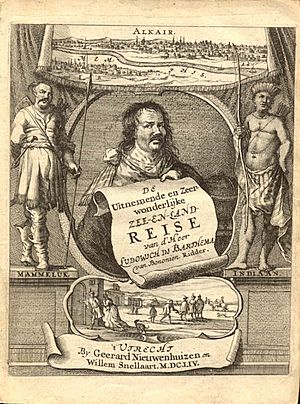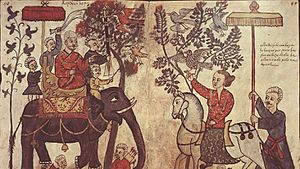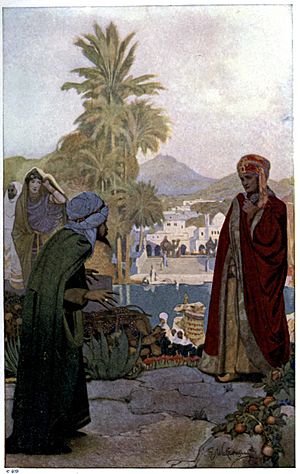Ludovico di Varthema facts for kids
Ludovico di Varthema (born around 1470, died 1517) was an Italian explorer and writer. He was one of the first non-Muslim Europeans to visit Mecca, a holy city for Muslims. We know almost everything about his life from his own travel book, Itinerario de Ludouico de Varthema Bolognese. It was published in Rome in 1510.
Contents
Ludovico di Varthema's Early Travels
Varthema was born in Bologna, Italy. He might have been a soldier before he started his long journeys. He seemed to travel because he loved adventure and wanted to become famous.
Journey Through the Middle East
Varthema left Europe in late 1502. In early 1503, he arrived in Alexandria, Egypt. He then traveled up the Nile River to Cairo. From Egypt, he sailed to Beirut and then went to Tripoli, Aleppo, and Damascus. In Damascus, he pretended to be a Muslim and joined the Mamluk army under the name Yunus.
Visiting Mecca and Medina
From Damascus, Varthema joined a group of pilgrims traveling to Mecca and Medina. This journey happened between April and June 1503. He described these holy cities of Islam and their ceremonies very well. His descriptions have been proven right by later travelers. Varthema was likely the first non-Muslim European to visit these cities.
While in Mecca, a Muslim merchant thought Varthema was a Christian spy. Varthema said he was a Mamluk, which calmed the merchant down. The merchant explained that people were worried because the Portuguese had started attacking Muslim ships in the Indian Ocean.
Varthema then came up with a clever plan to get to India. He pretended to be an expert at making cannons. He said he wanted to help the Muslim Sultan of Bijapur make weapons to fight the Portuguese. The merchant was impressed and hid Varthema in his home. The Mamluk group returned to Syria without him.
Adventures in Yemen
With the merchant's help, Varthema sailed from Jeddah (a port city near Mecca) towards India. His ship went down the Red Sea and through the Straits of Bab-el-Mandeb to Aden. But when he arrived in Aden, he was arrested. They thought he was a Christian spy working with Portuguese ships.
Varthema said he gained his freedom after being jailed in Aden and Radaa. He got help from one of the sultanas (queens) of Yemen. She kept him in her palace for a while. Varthema pretended to be sick to get permission to leave Radaa and find a cure in Aden. He then explored southwest Arabia, visiting San‘a’, before returning to Aden.
Exploring Persia
Varthema likely used money from the sultana to buy a ship ticket to India. It was March 1504. The ship was supposed to stop in the Persian Gulf. But strong winds pushed it south instead. It stopped in Zeila and Berbera on the coast of Somalia. He wrote short descriptions of both places.
From Somalia, the ship sailed across the Arabian Sea to Diu in Gujarat, India. From Diu, it sailed to Ghogha. After finishing business there, the ship sailed back across the Arabian Sea to the Persian Gulf. It landed at Julfar, then stopped briefly in Muscat, before going across the strait to Ormuz.
Varthema did not stay long in Ormuz. He then traveled across Persia. He went northeast to Herat and then southwest to Shiraz. Along the way, he saw a river he thought was the Euphrates.
In Shiraz, Varthema met a Persian merchant he had known in Mecca. The merchant, named "Cazazioner," became Varthema's business partner. Cazazioner still believed Varthema was a Muslim. Varthema was the junior partner, and Cazazioner seemed to want him to marry his daughter. Their future travels were mostly based on Cazazioner's business trips.
Ludovico de Varthema and his partner tried to join a caravan to Samarkand. But they had to turn back because of fighting in the area. Varthema mentioned the Safavid uprising, which was spreading in northern Iran. The caravan returned to Shiraz.
Adventures in India and Beyond
Journey Through India
With the land route blocked by war, Varthema and his Persian partner went from Shiraz to Ormuz. They took a ship to India, stopping at the mouth of the Indus River. From there, they sailed down the west coast of India, starting around October 1504.
Their first stop was the busy port of Cambay. Varthema described the Sultan of Cambay. They then went south, stopping at Chaul and Dabul, before reaching Goa. From Goa, Varthema and his partner traveled inland for seven days to Bijapur. This was the capital of the Adil Khan sultanate.
Returning to the coast, they continued south. They stopped at Ankala, Honavar, Bhatkal, and Mangalore. Most of these were ports that paid tribute to the Hindu kingdom of Vijayanagara.
They then reached Cannanore, one of the main cities on the Malabar Coast in Kerala. Varthema might have seen the first Portuguese people here. The Portuguese had a trading post in the city. He probably avoided them so his true identity would not be found out. From Cannanore, Varthema and his partner traveled overland for fifteen days. They went to the city of Vijayanagara, the capital of the Hindu empire. Varthema paused his story here to describe war elephants and the coins of south India. This was probably around December 1504.
Back on the coast, Varthema and his partner boarded a ship again. They sailed down the Malabar Coast, stopping at small ports. Finally, they reached the great city of Calicut. This was the main spice center on the Malabar Coast. However, the Portuguese had blocked trade in Calicut. This meant there were fewer goods to buy and sell.
Varthema then described Calicut in great detail. He wrote about the Zamorin's (the ruler's) court, government, and military. He also described the city's trade and the customs of Malabari society. This part of his book includes one of the first European descriptions of Hinduism and the caste system.
Varthema and his partner continued south through the Kerala backwaters instead of by sea. This was probably to avoid Portuguese ships. They passed Cochin, where the Portuguese were strongest. They sailed to "Cacolon" (probably Kayamkulam). Here, Varthema met Saint Thomas Christians for the first time. They soon reached the large city of Quilon. But since its ruler was a Portuguese ally, they did not stay long. They continued quickly by the coast again.
The ship carrying Varthema and his partner rounded Cape Comorin (the southern tip of India). They followed the coast northeast. They stopped at a small port called "Chayl" (likely a pearl fishing port near Tuticorin). They then went to a large port city Varthema called "Cioromandel," which seems to be Negapatam. This was a city under Vijayanagara on the Coromandel Coast of India.
Ceylon, Bengal, and Burma
Varthema and his partner stopped going further up the coast. There were reports of war in the area. Instead, they took a ship with other merchants across the Palk Strait to the island of Ceylon. His exact landing spot is not clear. He described the island, its four kingdoms, and its cinnamon farms. Their stay was cut short after Cazazioner got into trouble with a local Arab merchant. They sailed back to India, arriving three days later at Pulicat. This was another city under Vijayanagara on the Coromandel coast.
From Pulicat, Varthema and his partner sailed east across the Bay of Bengal. After fourteen days (around March 1505), they reached Tenasserim. This area is now part of Burma. Varthema described Tenasserim, its military, economy, and society. He mentioned groups of "Brahmins" (likely Buddhist monks) in the city.
After a few weeks in Tenasserim, Varthema and his partner sailed northwest to Bengal. After eleven days, they arrived at a port Varthema called "Benghalla," at the mouth of the Ganges River.
In Bengal, Varthema met two Chinese Christian merchants. These merchants were from a city called "Sarnau." They said there were "many other Christian lords" like them there, all subjects of the Great Khan of Cathay (China). The location of Sarnau is not clear, but it might have been Ayutthaya, the capital of Thailand. The Chinese emperor ruled over many kingdoms in Indochina. It was unusual to find Christians there at that time. However, some Christian groups had spread in Central Asia and China. They might have moved to Indochina after problems in China.
The two Chinese Christians convinced Varthema and Cazazioner to go with them. They all took a ship from Bengal across the bay to Pegu (lower Burma). They heard that the King of Pegu was away fighting. So, they went up the Irrawaddy River but soon returned to Pegu to wait for him.
The king arrived a few days later and met with them. With the Chinese Christians as translators, Cazizioner and Varthema sold the king some red coral. In return, they received many valuable Burmese rubies.
Malacca, Sumatra, and the Spice Islands
From Pegu, Varthema, his Persian partner, and the two Chinese Christians took a ship down the Malay peninsula to Malacca. This was a major trading center. They did not stay long in Malacca. They soon crossed the strait to Sumatra. They stopped at the port city of Pedir. Varthema described the large amounts of long pepper and different perfumed woods available there.
At this point, the two Chinese Christians wanted to go home to Sarnau. They tried to convince Varthema to come with them and return to his Christian faith. But Varthema said no, wanting to remain a Muslim convert. His Persian partner, Cazizioner, wanted to visit the famous Spice Islands. He wanted to see where cloves and nutmeg came from. He convinced the two Chinese Christians to join them.
They got two local sampans (flat-bottomed boats). They sailed east through the Indonesian islands. After fifteen days, they reached the Banda Islands, the only place in the world where nutmeg grew. From there, they sailed north for another twelve days. They reached the clove islands of the Moluccas (which Varthema called "Monoch"). Ludovico de Varthema might have been the first European to see these islands. He wrote a lot about how the spices were grown and their prices.
Return Journey: Borneo and Java
The Moluccas were the furthest east Varthema and his Persian partner traveled. It was around June 1505. Guided by the two Chinese Christians, they returned by a different route. First, they went to Borneo to find a larger ship. Then they headed south to Java. The Chinese Christians called Java the "largest island in the world."
Varthema noticed that the Malay pilot of their ship used a magnetic compass and a nautical chart with lines. This was common in the Mediterranean but unusual in the Indian Ocean. The Malay pilot also showed them how he used the Southern Cross to navigate. This was new to both Varthema and his partner.
The journey from Borneo to Java took five days. Varthema made some quick notes about Java. He saw that Hinduism was common there, unlike the Islam they had seen in other ports. Staying in Java for a couple of weeks, they decided it was time to go home. Before leaving, Varthema bought some emeralds and two slaves.
They hired a junk (a type of ship) from Java and sailed back to Malacca. There, Varthema and Cazizioner finally said goodbye to the two Chinese Christians. On the same Javanese junk, they sailed west across the Bay of Bengal for fifteen days. They reached the Coromandel Coast of India and got off at Negapatam. After a few weeks, they took a sampan to Quilon. Varthema was scared by the Portuguese presence in Quilon. He kept a low profile until he found a way to travel back to Calicut through the Kerala backwaters.
Return to Calicut
In Calicut, Ludovico de Varthema met two Italians, Pier'Antonio and Gian'Maria. They were military engineers hired by the Zamorin to make European-style cannons to fight the Portuguese. Varthema was separated from his Persian partner and felt homesick. He told the Italians he was a Christian and from Italy. The two Italians had arrived in India in 1502. They wanted to go home, but the Zamorin would not let them leave.
Varthema learned that the next Portuguese fleet was due to arrive in India soon. He decided to meet with the Portuguese captains and get passage back to Europe for all of them. However, the two Italians worried the Portuguese would not forgive them.
While in Calicut, Varthema kept meeting his new Italian friends. To avoid his Persian partner's suspicions, Varthema pretended to have a religious awakening. He said he wanted to live a stricter religious life. For a few weeks, Varthema lived as a Muslim ascetic in a Calicut mosque. He would sneak out at night to have dinner with the Italians. He was so convincing as a holy man that people even asked him for healing.
Finally, news reached Calicut that the Portuguese fleet had arrived in Cannanore. It was late October or early November 1505. Varthema arranged to leave for Cannanore with some Persian merchants. However, the Calicut authorities stopped their ship in the harbor. But they managed to sneak onto a smaller boat and finally made it to Cannanore. Cazizioner did not go with them but gave Varthema a letter for a merchant friend in Cannanore. Varthema never saw his old Persian partner again.
Joining the Portuguese
After a few days, Ludovico de Varthema secretly left his Persian hosts in Cannanore. He went to the Portuguese and told them he was a Christian. Varthema was taken to Fort Sant' Angelo in Cannanore. For three days, the Portuguese naval captain, D. Lourenço de Almeida, interviewed him. Varthema told Almeida all about the Zamorin's military plans, which he had seen in Calicut.
Almeida sent Varthema and his report to his father, D. Francisco de Almeida, the Portuguese viceroy in India. Almeida was very happy with the information and welcomed Varthema warmly. Varthema asked Almeida to give the two Italian engineers in Calicut a safe way to leave. Almeida agreed and sent Varthema back to Cannanore with instructions for his son Lourenço to help him. Varthema used a local spy network to talk to the Italians in Calicut. But the plan failed. A slave overheard their escape plan and told the authorities. Before the Zamorin's men could arrest them, an angry crowd attacked and killed the two Italians. Varthema heard this news in Cannanore in March 1506.
Later that month, Varthema saw the naval Battle of Cannanore between the Zamorin's fleet and the Portuguese fleet. He described it in detail. Soon after, the Portuguese hired Varthema at their trading post in Cannanore. He helped them enforce new shipping rules on the Malabar Coast. Varthema used his Arabic language skills to question local ship captains.
Ludovico de Varthema stayed in this job for about a year and a half. He was among the defenders during the difficult Siege of Cannanore. This lasted from April to August 1507. They were finally saved by the arrival of D. Tristão da Cunha's fleet. Varthema claimed that after the battle, some of his old friends became Christians. Varthema then joined a Portuguese attack led by Cunha on the port of Ponnani in November. For his brave actions there, Ludovico de Varthema was made a knight by the viceroy Francisco de Almeida in Cochin.
Returning to Europe
Ludovico de Varthema left India on December 6, 1507. He sailed from Cannanore on a Portuguese ship. He was on the São Vicente, a ship owned by a Florentine merchant. They followed the usual route back, crossing the Indian Ocean and sailing down the East African coast. Their first and only stop was Mozambique Island. Varthema mentioned other places along the Swahili coast, but he likely only heard about them from the Portuguese.
Varthema briefly described Mozambique Island and its people. He mentioned the new Portuguese fort being built there. He also talked about Francisco de Almeida's raids in 1505 and Tristão da Cunha's trip to Madagascar. Varthema hoped that all of Asia would eventually become Christian.
After a short rest, the journey continued. The fleet sailed down the Mozambique Channel and rounded the Cape of Good Hope. A storm soon hit, scattering the fleet. The São Vicente sailed on alone. Varthema reported that they passed near the islands of Saint Helena and Ascension in the South Atlantic. After crossing the equator, they stopped in the Azores islands for a couple of days. They reached Lisbon about a week later.
Soon after arriving, Ludovico de Varthema met with the Portuguese king Manuel I. He wanted the king to confirm the knighthood he received in India. After that, Ludovico de Varthema returned to Rome, Italy. His travel book ends here, so we have no more details about his life.
Varthema's Work and Importance
Richard Francis Burton once said that Varthema was one of the best old Oriental travelers. He noted Varthema's sharp observations and quick thinking. In Arabia and the Indian islands east of Java, Varthema was a true discoverer for Europeans. Even when he traveled through places others had explored, his intelligence often added new and valuable details about people, customs, laws, religions, products, trade, and ways of war.
Varthema's book, "Itinerario de Ludouico de Varthema Bolognese," was first published in Italian in Rome in 1510. Many other Italian editions came out later. Latin translations also appeared. The book has been translated into 50 languages.
|
See also
 In Spanish: Ludovico de Varthema para niños
In Spanish: Ludovico de Varthema para niños





